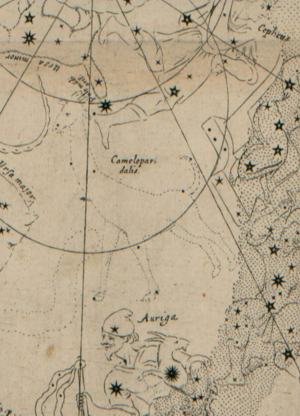Camelopardalis
One of the 88 IAU constellations.
Etymology and History
Camelopardalis was invented in 1612 by Petrus Plancius and represents a giraffe. The constellation’s name is Greek Καμηλοπάρδαλις, which was adopted by ancient authors into Latin Camelopardalis (e.g. Pliny the Elder, Naturalis Historia VIII, 69), derived from the words for “camel” and “leopard”, reflecting an animal suited to hot climates like a camel, yet marked with spots like a leopard.
Origin of Constellation
Petrus Plancius (...)
[to be written]
Jacob Bartsch (1600-1632)
In 1624, Bartsch published Usus astronomicus planisphaerii stellati, a book of star charts that included several new constellations first proposed around 1613 by the Dutch cartographer Petrus Plancius. Among these was Camelopardalis, the constellation representing a giraffe, which Bartsch depicted on his charts based on Plancius’s celestial globe created by Pieter van den Keere.
Bartsch's description of the constellation in Usus astronomicus planisphaerii stellati reads:
V. CAMELOPARDALIS, Καμηλοπάρδαλις, Ital. Giraffa, Greyff, animal cameli proceritate, pantherae colore, bovis pedibus: ex informibus circa polum arcticum, iis stellulis Cassiopeiae & Aurigam, recentioribus sic formatur. Mihi sit Camelus Rebeccae, quo cum Abrahami servo ad Isacum profecta. Gen. 24. v. 61 & 65.
Camelopardalis, Καμηλοπάρδαλις, in Italian Giraffa, the giraffe. An animal the height of a camel, the colour of a panther, and the feet of an ox. It is formed from faint stars near the Arctic Pole, between Cassiopeia and Auriga, as established by more recent astronomers. Let it be to me the camel of Rebecca, with which she journeyed with Abraham’s servant to Isaac. (Genesis 24:61, 65)







